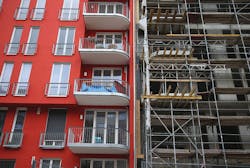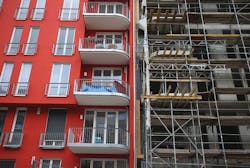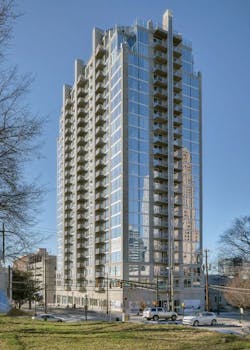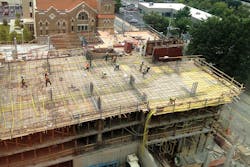As electrical subcontractors, we are frequently asked the same two questions: What makes a successful project, and how do you decide where to spend your time and energy regarding the work you perform?
At Faith Technologies, the way we answer these questions typically comes from past experiences and perception of the future. If history really does repeat itself, then duplicating successes and avoiding failures is the simple formula needed to prosper as a subcontractor. As with most “gambles,” the more predictable you can make the outcome, the more likely you will be successful at it. So, if predictability is the key, how do you, as a subcontractor, find and/or create it?
It’s been said that repetition is the mother of learning. If this is true, then repetition in construction (in all its forms) should lead to a predictable, positive outcome. Unfortunately, this isn’t always the case. Repetition by itself is a process — one that can result in either positive or negative outcomes. To succeed, you must identify obstacles before they occur and put in place processes that will help to overcome these hurdles, thus ensuring a positive, predictable outcome.
Only a few construction markets truly lend themselves to this type of repetition. Two of these include the multifamily and hospitality markets. By their nature, these types of projects are designed, budgeted, and constructed using a reoccurring metric that is measurable, and, if managed properly, predictable.
Understand industry influencers
A number of trends — some of which are the result of the Great Recession — are currently affecting the uptick in the U.S. multifamily housing market. These include:
Strict personal lending restrictions: Because rental rates are expected to continue to rise at a 4% annual rate, experts predict a 9% growth in multifamily construction over the next five to six years. One key indicator of a slowing market will be the ease on lending restrictions, which correspond to an increase in housing purchases, making apartment construction negligible.
Movement toward urban living: With the strict personal lending and depressed wages, many Americans are turning (or returning) to an urban lifestyle. This social trend is occurring near major metropolitan cities across the United States, allowing individuals to enjoy an active night life, access to mass transportation, as well as food service conveniences (e.g., restaurants, grocery stores).
We have seen a significant increase in high-rise and high-density apartments, privatized student housing, hotels, and assisted living facilities in both primary and secondary geographic markets (i.e., Atlanta, Dallas, Houston, Charlotte, Tampa, and Nashville) as well as Division I, II, and III college campuses around the country.
One reason urban growth is outpacing traditional mega cities is an ongoing technical talent recruitment effort, particularly in the Sunbelt states. Research suggests these states are consistently adding to the number of college graduates, as well as attracting a steady influx of foreigners with technical education.
Skilled labor shortage: As a result, today’s market conditions appear to be recognizing a need for these project types around the country. However, with the increasing demand, the supply of competent, cost-effective construction teams with sufficient labor to deliver the projects on schedule is becoming harder to find. Now more than ever, owners are looking for construction teams who will commit to their growth and put a workforce in place to consistently deliver projects in an economical and predictable manner.
Increased project marketability: Owners are more easily able to justify their pro forma to investors based on need and a trend toward urban living. Additionally, developers are willing to invest more money in a project in order to increase its marketability as a capital asset. LEED certification is one example how this is done. These certifications, along with energy-efficient design solutions and lean construction practices, increase the value of the project. Today’s high-rise multifamily structures are a good example of lean construction. Built with narrow structural bases on much smaller tracts of land, these buildings are 20 to 40 stories high — much taller than those built prior to the recession.
Start with design
The predictability seen in multifamily construction begins with design. By selecting a design/build or design/assist delivery method, the knowledge base for the project is expanded significantly so the good and bad lessons learned are brought into the design early. Issues concerning budget, constructability, schedule, multi-trade coordination, and sequencing are factored into the process usually not seen in the traditional design/bid/build approach. In fact, using the traditional approach, the predictability of the project outcome is relegated to a system that is driven by a win/lose approach to business — one based primarily on contract management and low price.
Another advantage for the multifamily and hospitality markets is the ability to integrate prefabricated assemblies into the design. This single preconstruction effort will improve labor efficiencies, increase safety by reducing the number of work hazards onsite, and enhance the quality of work by producing the assembly off-site in a controlled environment. By providing more control in the process, the outcome is made more predictable.
When a contractor is pursuing multifamily projects on a national level, it’s important to have an understanding of the local market conditions. The subcontractor must bring to the team early in the process an understanding of the local code and permitting requirements that will affect the project. In addition, an understanding of all utility requirements concerning electrical and communication services early in the process will contribute to a successful outcome. Because the owner, in many instances, creates the pro forma based on historical information, it’s important for you to identify the unique site-specific elements that will affect the budget early in the process.
Maximize on predictability
As an organization, we have seen consistent growth in high-density apartment rentals across the United States, which consequently has positively impacted the development of buildings within the commercial market, such as retail, food service, entertainment, and medical office.
As a result of this continued growth, we have begun to make changes like creating a vertical market dedicated to multifamily construction. We’ve observed a fundamental shift in the market approach placing a greater emphasis on the speed to market, meaning a construction cycle is built on lean practices focused on a fast-paced overall project schedule. Simply put, the faster the build cycle, the leaner and more efficient a contractor must be in order to deliver the project on time and under budget. To accommodate this approach, we believe contractors should develop processes and procedures to support building and management best practices. We have determined the multifamily market offers an opportunity to maximize on predictability. As with most projects, proper planning is important. If the planning can be simplified by using the efficiencies driven by repetition, then a successful outcome can be made more predictable. We have also invested in training to educate our workforce on these best practices, ensuring a foreseeable and measurable outcome, and establishing a framework by which the project is delivered.
We have become much more strategic in project pursuits as an organization, basing selections on available resources and the likelihood of the project actually starting. There is a much more heightened awareness of project start dates, overall project durations, and project funding to ensure the proper resources will be available — to prevent backlog gaps and to minimize missed opportunities. Qualifying the project opportunity is more important now than ever.
Brock is vice president of preconstruction and Akin is vice president – Atlanta for Faith Technologies. Brock can be reached at [email protected] and Akin can be reached at [email protected].



